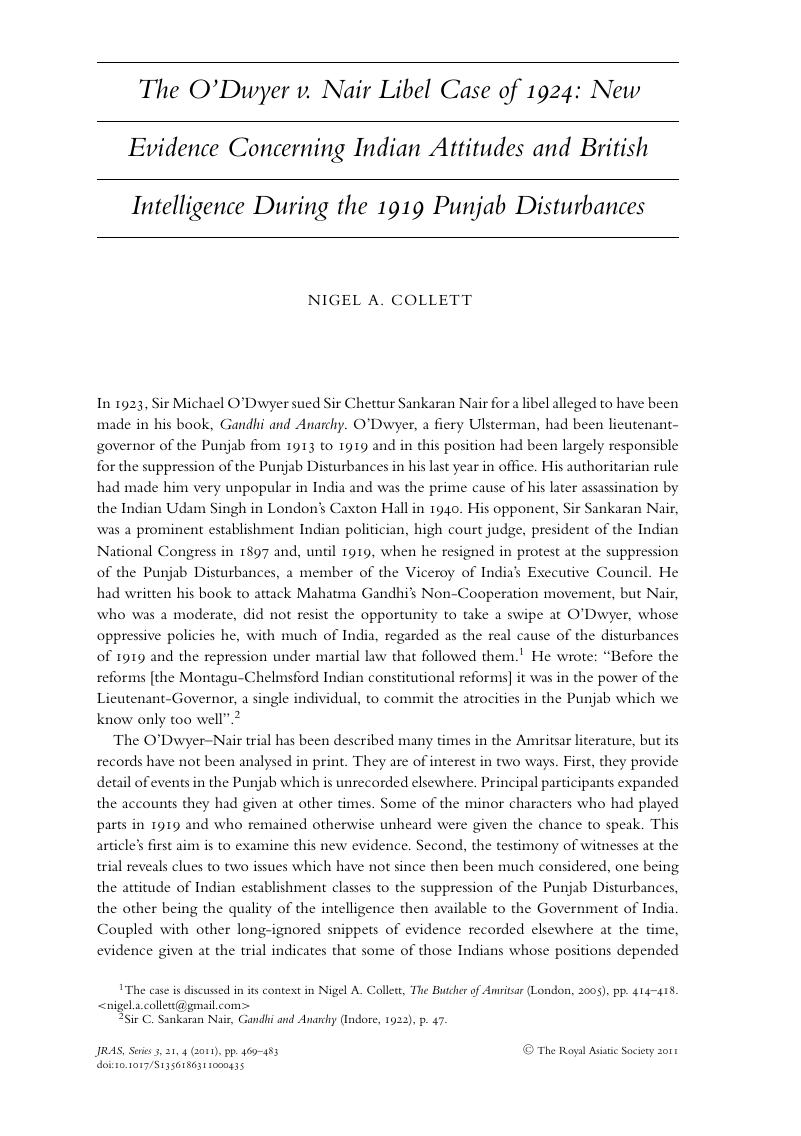Published online by Cambridge University Press: 29 November 2011

1 The case is discussed in its context in Collett, Nigel A., The Butcher of Amritsar (London, 2005), pp. 414–418Google Scholar. <[email protected]>
2 SirNair, C. Sankaran, Gandhi and Anarchy (Indore, 1922), p. 47Google Scholar.
3 For Justice McCardie and the case, see Pollock, George, Mr Justice McCardie: A Biography (London, 1934), pp. 132–136Google Scholar.
4 The Times, Law Reports, 7–31 May, 3–6 June 1924.
5 The Times, Law Reports, 3 June 1924.
6 The depositions are at: O'Dwyer v. Nair, Supreme Court of Judicature, Depositions – Exhibits Taken off the File, 16 January 1924, J17/634, National Archive, Kew. They are analysed in Nigel A. Collett, “The Jallianwala Bagh Revisited”, The Journal of the United Service Institute of India, Part One: CXXXVI, No. 564 (April–June 2006); Part Two: CXXXVI, No 565 (July–September 2006).
7 Witness statements are in The Congress Punjab Inquiry 1919–1920, ii, Evidence (New Delhi, 1996).
8 Pollock, Mr Justice McCardie, p. 135.
9 The depositions entered into the trial provided the only documentary evidence that the meeting was indeed a political one. The deposition of Rup Lal Puri included the five resolutions which were to have been put to the meeting in the Bagh. The original of this document has not been located, but it is reported in full in The Times law reports; see Collett, The Butcher of Amritsar, pp. 246–247.
10 Command 681: Parliamentary Papers (Commons), 1920, vol. 14, Reports, vol. 6, “East India (Disturbances in the Punjab, etc)”. “Report of the Committee Appointed by the Government of India to Investigate the Disturbances in the Punjab, etc.” (henceforth Hunter Report).
11 Detail of these events is found in Collett, The Butcher of Amritsar, pp. 229–293.
12 The Times, Law Report, 14 and 15 May 1924.
13 Ibid., 14 May 1924.
14 See the discussion in Collett, The Butcher of Amritsar, pp. 240–241.
15 Botting exaggerated the strength of his force. Dyer's report to the 16th Division dated 25 August 1919, Appendix XIII, a list of troop strengths on 11 and 20 April 1919, is confused but puts the figures at 41 British troops in No. 12 Column plus 46 men of the Royal Garrison Artillery and 16 of the Indian Defence Force, all of which were presumably under Botting's command, a total of 103 on 11 April; Report from Brigadier-General R.E.H. Dyer, Commanding 45th Brigade, to the General Staff, 16th (Indian) Division, 25 August 1919, in the Hunter Report, Evidence, iii, Appendix XIII.
16 The Times, Law Report, 21 May 1924.
17 Ibid., 20 May 1924.
18 Neither telegram has yet been located.
19 “He told me not to bother about Lahore, but to go and look after Amritsar”; The Times, Law Report, 24 May 1924.
20 Hunter Report, Evidence, iii, pp. 163–165.
21 The Times, Law Report, 24 May 1924.
22 Collett, The Butcher of Amritsar, p. 264.
23 Hunter Report, Evidence, iii, pp. 123, 126.
24 Collett, The Butcher of Amritsar, p. 357.
25 Hunter Report, vi, in V.N. Datta (ed.), New Light on the Punjab Disturbances in 1919, i, (Simla, 1975), p. 210.
26 SirO'Dwyer, Michael, India as I Knew It (London, 1925), p. 272Google Scholar, where he says he has “irrefutable” evidence of eighteen attempts to tamper with troops in the Punjab, six of which were partially successful, but that he had not told Simla of them so that perhaps the Government of India had not known of them.
27 Hunter Report, vii, in Datta, New Light on the Punjab Disturbances in 1919, ii, p. 1143.
28 Captain Ulrich Nisbet, “Diaries and Memories of the Great War”, Imperial War Museum, 78/3/1, p. 1.
29 Mrs Melicent Wathen, “Diary”, in the possession of the Reverend Mark Wathen.
30 Hunter Report, Evidence, iii, p. 223.
31 Hunter Report, Evidence, iii, pp. 118, 163–165, 223.
32 Collett, The Butcher of Amritsar, p. 243.
33 Collett, N., “The Jallianwala Bagh Revisited”, The Journal of the United Service Institute of India, Part Two: CXXXVI, No. 565 (July–September 2006), pp. 481–482Google Scholar.
34 Hunter Report, vi, in Datta, New Light on the Punjab Disturbances in 1919, i, pp. 69, 70 and 202.
35 O'Dwyer, India as I Knew It, p. 263.
36 Hunter Report, vi, in Datta, New Light on the Punjab Disturbances in 1919, i, pp. 792–793.
37 Hunter Report, vi, in Datta, New Light on the Punjab Disturbances in 1919, i, p. 232.
38 Hunter Report, vi, in Datta, New Light on the Punjab Disturbances in 1919, i, pp. 376–377.
39 Hunter Report, vi, in Datta, New Light on the Punjab Disturbances in 1919, i, p. 880.
40 For instance, Collett, The Butcher of Amritsar, p. 226.
41 Sir Percival Griffiths, To Guard My People, the History of the Indian Police, pp. 347 ff.
42 Hunter Report, vi, in Datta, New Light on the Punjab Disturbances in 1919, i, pp. 202 and 790.
43 Collett, The Butcher of Amritsar, p. 253.
44 Hunter Report, vi, in Datta, New Light on the Punjab Disturbances in 1919, i, pp. 37 and 39.
45 Collett, The Butcher of Amritsar, pp. 291–292. See also Singh, Mohinder, “Jallianwala Bagh and Changing Perceptions of the Sikh Past” in Datta, V.N. and Settar, S. (eds), Jallianwala Bagh Massacre, (Delhi, 2000)Google Scholar, which discusses the reaction against this by lower-class Sikhs which led to the Akali movement.
46 Grewal, J. S., The Sikhs: Ideology, Institutions, and Identity (New Delhi, 2009), pp. 251Google Scholar ff; Bhatia, H.S. and Bakshi, S.R., Encyclopaedic History of the Sikhs and Sikhism, (New Delhi, 1999), v, p. 86Google Scholar; Chabra, G.S., Advanced Study in the History of the Punjab (Ludhiana, 1962), ii, pp. 440–441Google Scholar; Singh, Mohinder, “Gurdwara Reform Movement”, in Dayal, Ravi (ed.), We Fought Together for Freedom (Delhi, 1995), p. 107Google Scholar; Singh, Mohinder, The Akali Struggle: A Retrospect (New Delhi, 1988), pp. 14–16Google Scholar.